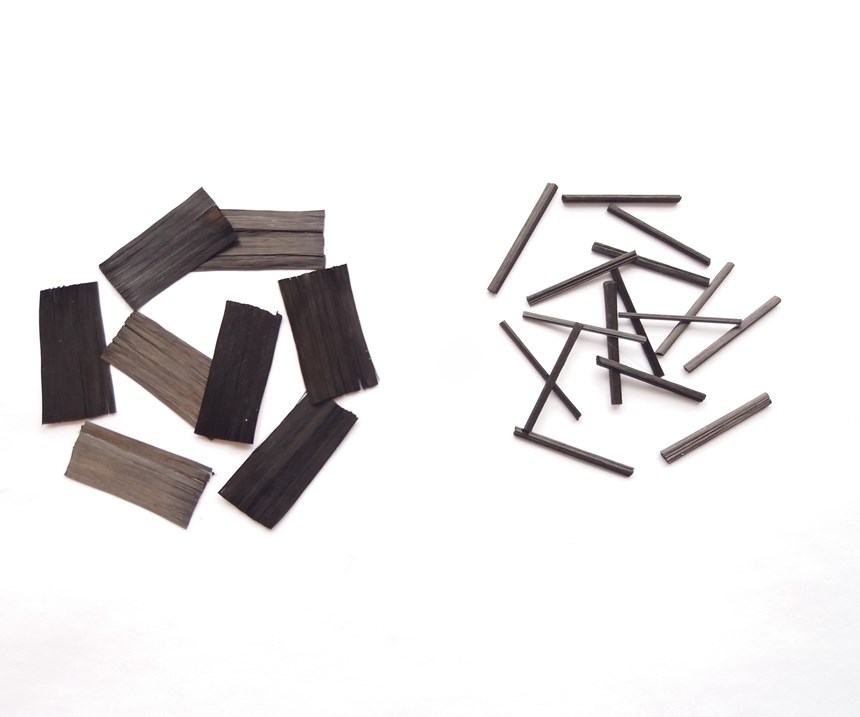A novel carbon fiber product designed and sized to improve the performance of sheet molding compound (SMC) has been commercialized by Zoltek Corp., a Toray Group company (Bridgeton, Mo., U.S.). The patented, pre-spread fiber, called PX35 KS, is scored as the tow band is produced, converting a 50K tow product into 3K sub-bundles, which, in turn, are spooled and supplied as a multi-end tow. Once the pre-scored tow is fed into a chopper unit and the tow’s fiber length is cut, it falls apart into the 3K sub-bundles as it is compounded into the SMC dough. Reportedly this improves fiber handling, dispersion and wetout, and provides a more uniform fiber bed that improves the flow of the composite during compression molding.
“The benefit of improved dispersion is that it allows manufacturers to use a lower-cost carbon fiber while achieving the higher properties typically seen by a smaller tow,” notes Christopher Thomas, Zoltek automotive business director-Americas. “You essentially pay for the cost of 50K [automotive-quality tow], but you get the performance of 3K [aerospace-quality tow],” adds Tobias Potyra, Zoltek automotive business director-Europe.
Zoltek, which is known for its large-tow, low-cost carbon fiber, developed the new product in Japan to address the challenge of dispersing large fiber bundles, especially in thixotropic polymer systems like SMC. “The concept was that separating the large tow into smaller tow sizes would provide for better dispersion at the cutter,” continues Thomas. He adds that sampling to select customers in Europe and North America has ramped up over the last year-and-a-half to two years, where it’s being evaluated for both structural and appearance parts. “The customers who’ve trialed the product have seen its benefits firsthand,” he adds. Not surprisingly, the primary market for which the split-tow product was developed is automotive, although reportedly any SMC compounder or molder could benefit from the approach taken with PX35 KS.
In terms of SMC resin materials, the new split-tow product has been tested in three single-resin systems: vinyl ester, epoxy and urethane matrices. Unsaturated polyester matrices were not investigated, since the presence of carbon fiber reinforcement already indicated the formulations would be used in higher temperature environments and/or in applications whose load cases required higher mechanical performance. The vinyl ester formulations were described as solvated (as opposed to hot-melt) systems, although they ranged from conventionally styrenated, to reduced styrene/volatile-organic compound (VOC), to no styrene/VOC systems. Reportedly, the same dispersion improvements were seen in each of the resin systems.
The product has not yet been evaluated in any other thermoset or thermoplastic chemistries, nor has it been tried in other forming systems beyond compression molding. “Although the fiber was developed for SMC and is available with a sizing for SMC resins, we see a potential for applying the technology to other processing technologies and resin types — possibly even thermoplastics,” explains Potyra. “However, we have not yet tested it in those systems because we first wanted to implement this fiber type in SMC successfully before we expanded its use to other technologies.”
No significant changes to the chopper are said to be needed with the new product, although some other process modifications might optimize the dispersion. “The design of SMC lines can vary, so technical assistance is available from Zoltek to help with fiber handling, dispersion, sizings and the like,” adds Thomas.
PX35 KS is based on Zoltek’s popular PX35 50K fiber. “PX35 KS is addressing and matching industrial needs in terms of availability and pricing but we, of course, also offer our standard 50K product for some applications at a slightly lower price,” notes Potyra. “In the end, we will let the market decide.”
Zoltek officials did not say whether there would be other variants on the product with either finer or coarser tow sizes, although they did add that further evaluations would continue. Unofficially, the “KS” in the product’s name is reportedly an abbreviation for “kassen,” the Japanese word for “split.”
Related Content
Infinite Composites: Type V tanks for space, hydrogen, automotive and more
After a decade of proving its linerless, weight-saving composite tanks with NASA and more than 30 aerospace companies, this CryoSphere pioneer is scaling for growth in commercial space and sustainable transportation on Earth.
Read MoreTU Munich develops cuboidal conformable tanks using carbon fiber composites for increased hydrogen storage
Flat tank enabling standard platform for BEV and FCEV uses thermoplastic and thermoset composites, overwrapped skeleton design in pursuit of 25% more H2 storage.
Read MoreSulapac introduces Sulapac Flow 1.7 to replace PLA, ABS and PP in FDM, FGF
Available as filament and granules for extrusion, new wood composite matches properties yet is compostable, eliminates microplastics and reduces carbon footprint.
Read MorePlant tour: Joby Aviation, Marina, Calif., U.S.
As the advanced air mobility market begins to take shape, market leader Joby Aviation works to industrialize composites manufacturing for its first-generation, composites-intensive, all-electric air taxi.
Read MoreRead Next
All-recycled, needle-punched nonwoven CFRP slashes carbon footprint of Formula 2 seat
Dallara and Tenowo collaborate to produce a race-ready Formula 2 seat using recycled carbon fiber, reducing CO2 emissions by 97.5% compared to virgin materials.
Read MorePlant tour: Daher Shap’in TechCenter and composites production plant, Saint-Aignan-de-Grandlieu, France
Co-located R&D and production advance OOA thermosets, thermoplastics, welding, recycling and digital technologies for faster processing and certification of lighter, more sustainable composites.
Read More“Structured air” TPS safeguards composite structures
Powered by an 85% air/15% pure polyimide aerogel, Blueshift’s novel material system protects structures during transient thermal events from -200°C to beyond 2400°C for rockets, battery boxes and more.
Read More

.jpg;width=70;height=70;mode=crop)

























